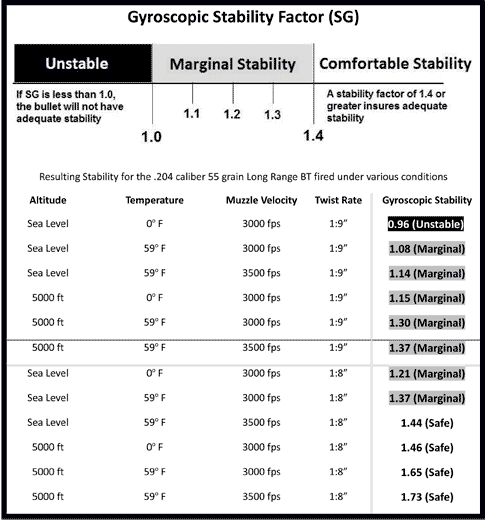The data in this article is out of date. For up to date information on twist rates, please visit our twist rate calculator at https://bergerbullets.com/twist-rate-calculator/.
As shooters of low drag spin stabilized projectiles, we’re compelled to understand the twist requirements of our bullets. In most cases, this is a simple matter of looking up what the manufacturers recommended twist rate is and making sure our barrel satisfies it. Occasionally you can get away with using a slower twist than what’s recommended if you’re shooting in favorable conditions. The manufacturers recommended twist rate is intended to ensure stability for any and all possible shooting situations, which means it’s sometimes faster than necessary for favorable or even average conditions.
This is exactly the case with our new .204 caliber 55 grain Long Range BT bullet. Because of this bullet’s weight and length, it has a faster twist requirement than most other .20 caliber bullets. We recommend a minimum twist of 1:8” to ensure stability for this bullet in all shooting conditions. Due to the popularity of the standard 1:9” twist for .20 caliber barrels, many shooters may be bummed to see the 1:8” recommended twist for this bullet. This web log entry is intended to shed some focused light on the stability requirements of this new bullet so it doesn’t get passed over by everyone with a 1:9” twist barrel. It is possible that your 1:9” twist barrel may stabilize these new bullets just fine depending on what conditions you’re shooting in.
In general, favorable conditions for stability are conditions that result in less dense air. Basically, warmer air and lower pressure (high altitude) will produce less dense air and aid stability. The data given in the Figure below illustrates the effects of various conditions and muzzle velocities on the stability of this particular bullet.
The gyroscopic stability factor (SG) is the measure of stability for spin stabilized bullets. In theory, SG needs to be above 1.0 to produce stability, but in practice, it’s a good idea to pad that with a margin of error. Most sources recommend an SG of at least 1.4 in nominal conditions to insure stability, and that’s what our recommended twist rate of 1:8” is based on. However, as you can see in the data, the 1:9” twist barrel produces stability that’s in the grey area of possible stability for many conditions.
These stability calculations have some error associated with them. Furthermore, the actual twist rate of barrels may also have some uncertainty (+/-). Ultimately the stability map below only shows that it may be possible, and is quite likely in favorable conditions, to successfully stabilize the new .20 caliber 55 grain bullets with a 1:9” twist barrel.
(click to expand)
In addition to the theory, we’ve had several field reports so far from a shooter who’s tried the new bullets in a 1:9” twist barrel and has had great success with them. Scott Green shoots a 20BR with a 26” long 1:9” twist 3 groove Pac Nor barrel. At 135 feet above sea level and 50-60 degrees F with muzzle velocity between 3550 and 3800 fps, Scott was grouping in the .2’s and .3’s at 100 yards. Groups around 1” were achieved at 300 yards, and 3” at 500. According to the calculations, these bullets were being launched with a stability factor of around 1.12 and doing just fine for several days of testing.
I would like to encourage anyone else who’s experimented with these bullets in a 1:9” twist barrel to share your experience by commenting on this blog. Please describe all the conditions of your test that would influence stability including: temperature, air pressure or altitude above sea level if known, muzzle velocity and your shooting results. By compiling case studies in addition to the data presented above, we should gain a complete and accurate understanding of the conditions that these bullets can and cannot work with in a 1:9” twist barrel.
Bryan Litz
Ballistican
